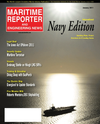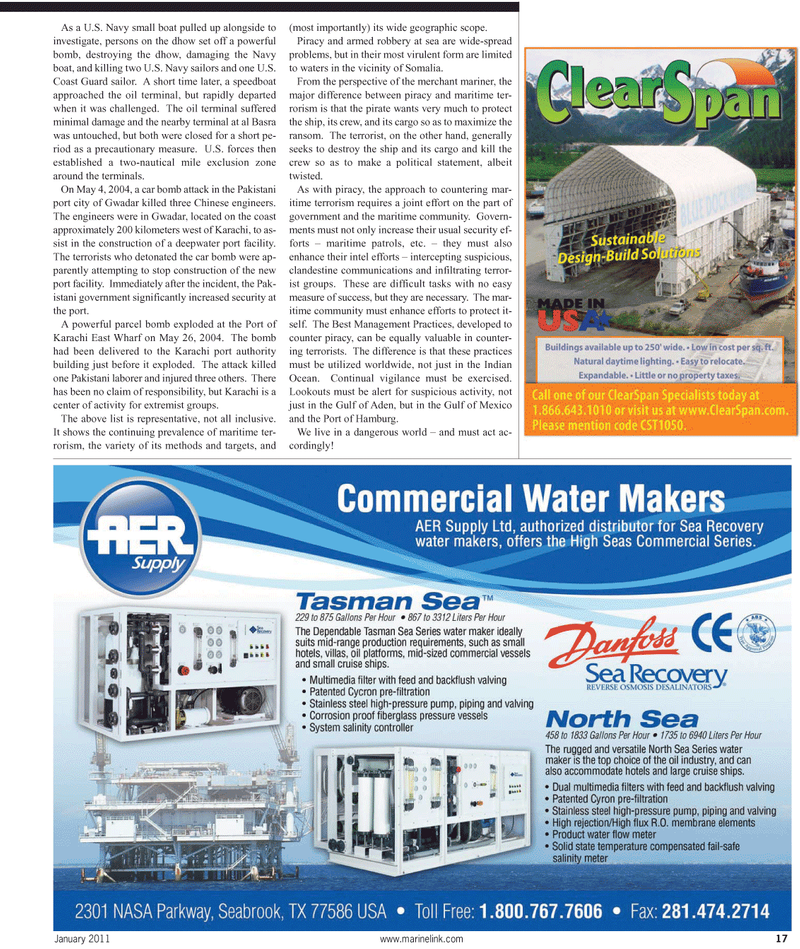
Page 17: of Maritime Reporter Magazine (January 2011)
International Naval Technology
Read this page in Pdf, Flash or Html5 edition of January 2011 Maritime Reporter Magazine
January 2011 www.marinelink.com 17
As a U.S. Navy small boat pulled up alongside to investigate, persons on the dhow set off a powerful bomb, destroying the dhow, damaging the Navy boat, and killing two U.S. Navy sailors and one U.S.
Coast Guard sailor. A short time later, a speedboat approached the oil terminal, but rapidly departed when it was challenged. The oil terminal suffered minimal damage and the nearby terminal at al Basra was untouched, but both were closed for a short pe- riod as a precautionary measure. U.S. forces then established a two-nautical mile exclusion zone around the terminals.
On May 4, 2004, a car bomb attack in the Pakistani port city of Gwadar killed three Chinese engineers.
The engineers were in Gwadar, located on the coast approximately 200 kilometers west of Karachi, to as- sist in the construction of a deepwater port facility.
The terrorists who detonated the car bomb were ap- parently attempting to stop construction of the new port facility. Immediately after the incident, the Pak- istani government significantly increased security at the port.
A powerful parcel bomb exploded at the Port of
Karachi East Wharf on May 26, 2004. The bomb had been delivered to the Karachi port authority building just before it exploded. The attack killed one Pakistani laborer and injured three others. There has been no claim of responsibility, but Karachi is a center of activity for extremist groups.
The above list is representative, not all inclusive.
It shows the continuing prevalence of maritime ter- rorism, the variety of its methods and targets, and (most importantly) its wide geographic scope.
Piracy and armed robbery at sea are wide-spread problems, but in their most virulent form are limited to waters in the vicinity of Somalia.
From the perspective of the merchant mariner, the major difference between piracy and maritime ter- rorism is that the pirate wants very much to protect the ship, its crew, and its cargo so as to maximize the ransom. The terrorist, on the other hand, generally seeks to destroy the ship and its cargo and kill the crew so as to make a political statement, albeit twisted.
As with piracy, the approach to countering mar- itime terrorism requires a joint effort on the part of government and the maritime community. Govern- ments must not only increase their usual security ef- forts – maritime patrols, etc. – they must also enhance their intel efforts – intercepting suspicious, clandestine communications and infiltrating terror- ist groups. These are difficult tasks with no easy measure of success, but they are necessary. The mar- itime community must enhance efforts to protect it- self. The Best Management Practices, developed to counter piracy, can be equally valuable in counter- ing terrorists. The difference is that these practices must be utilized worldwide, not just in the Indian
Ocean. Continual vigilance must be exercised.
Lookouts must be alert for suspicious activity, not just in the Gulf of Aden, but in the Gulf of Mexico and the Port of Hamburg.
We live in a dangerous world – and must act ac- cordingly!

 16
16

 18
18
